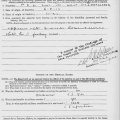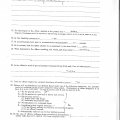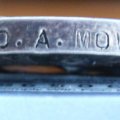Oliver's Military and Battle Honors 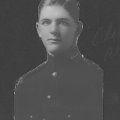 Captain Oliver Alexander Mowat, M.C.
Captain Oliver Alexander Mowat, M.C.
Born
in New Westminster B.C. on 8 Aug 1893. Son of Lumber Baron Maxwell M.
Mowat and his wife Lillian. When Oliver was only 2 years old his family
moved back to Campbellton. And in 1910 he enlisted in the Sussex
Militia until 1911.
I have no stories of his childhood as all
relatives that would have known him have since passed on or are too
young to remember. It wasn’t until his enrollment in the Forces that I
got to know Ollie. As best as one can from words on a paper. It states
on his attestation papers that he was a commercial Traveler. In reading
letters that he wrote home to his parents you can definitely see that
he had a sense of humor. You can also tell that he was very fun loving,
had a huge heart and really cared for his family. He mentioned many
times about his younger brothers and how important it was for them to
go to school, and get good grades. Even through all the hell he went
through over in the trenches of France and Belgium from Vimy to
Flanders he still wrote to make sure that everyone back home was
alright. Many times mentioning to his mother for her not to worry about
him. He was going to do all the worrying for both of them.
In
1914 Oliver went to the RMC in Kingston Ontario and took the Artillery
Lieutenant’s Instructor’s course. Upon graduation he was given his
commission and assigned to the 24th Battery Canadian Field Artillery
stationed at Fredericton New Brunswick.
When sent overseas he was
attached to the 10th Battery 3rd Brigade 1st Division Canadian Field
Artillery. He was mentioned in the war diary many times from July 1916
to August 1917.
On Oct 2 1916 he was wounded only slightly but
still remained on duty. There is no mention of what sort of injury he
received. But obviously Ollie didn’t think it serious enough to warrant
seeing the medic. Even his commanding officer told him to go. I guess
stubbornness started early in our family.
On 9 Oct 1916 he was
promoted to Capt. Due to the promotion of the present Capt. August of
1917 he was severely wounded and spent the rest of the fall and winter
at his home in Campbellton. According to the military he had served his
time and was offered the command of the Newcastle Wireless Garrison and
a position in Woodstock for the duration of the war. In an excerpt from
the Campbellton graphic, it states that Oliver “felt it was his duty to
return to active service”
In February of 1918 he left for
overseas again and arrived in England’s Whitney Camp. It was here that
the 67th and 68th batteries were being organized for the Canadian
Siberian Expeditionary Force or the Northern Russia Expeditionary
Force. Here he was appointed Adjutant. Along with these Duties he was
also President of the Court of Inquiry as well as prosecutor of Court
Martials. He held this position until he was medically cleared to go
back to active service.
Very soon after that 67 and 68 batteries
left for Russia. In an article published in the The Fourth Dimension in
January 2005 it explains how Oliver died. For those of you who have
read The Gunners Of Canada, you will be familiar with this battle as
well as the Russian Campaign. The article from The Fourth Dimension is
posted a little further down the page.
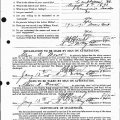
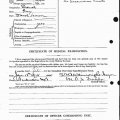 These are Ollie's Attestation Papers
These are Ollie's Attestation Papers
I
know everyone wants to see his Military Cross and all his awards but I
first have to put in all the little tid bits of his career up until
then. The following photos have been taken from The
Archives of Canada. These are the actual war diaries that were
written by the commanding officer or officer in charge of the daily
goings ons.

LIEUT. OLIVER MOWAT
Wounded
Ottawa Oct., 6
Max. M. Mowat,
Campbellton, N.B.
Sincerely
regret to inform you Lieut. Oliver Alexander Mowat, artilery,
officially reported wounded. Remaining on duty Oct. 1st, 1916.
Officer in Charge Record Office.,
Lieut.
Mowatt, of the 10th Battery, 3rd Brigade, D.F.A., is brother of Lieut.
G.A. Mowatt, of the 26th Batt., who was wounded some time ago and is
now convalescing at his home here. Lieut. Oliver Mowatt was some months
ago mentionned in despatches for gallantry in taking a field gun into
the front line trenches and successfully blowing up a section of enemy
parapet.
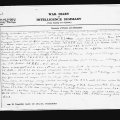
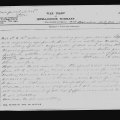
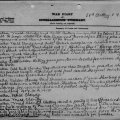 22
July 10
Feb 1916
Diary
22
July 10
Feb 1916
Diary
Oliver's Medical Records
Oliver's Hall Of Fame!

This is the Cross of Sacrifice. It was given to the mothers of soldiers who were killed in the war.
Mike
Grobbel put together a webpage about Ollie long before I ever started
researching him. He cites books and passages that Ollie was
mentioned in. I am proud that someone would think enough of
him to devote an entire page to Ollie. This page can be viewed
here. He has also done a lot of work on the Polar Bear
Expedition. Mike was kind enough to send me the links to everything he
had found about Ollie and allow me to post them on my website.
You'll notice that on the Mike's page there is a link to the "Godfrey J.
Anderson Papers" in which Godfrey writes about Ollie in the hospital.
He refers to him as Capt Moffat but it's close enough. Capt. Mowat's story in North Russia is also told on pages 192-193 in Damien Wright's book "Churchill's Secret War with Lenin".
The 1958 book "The Ignorant Armies"
by E. M. Halliday makes numerous references to Capt. Mowat in the
closing pages of Chapter 8, "The Snows of Nijni Gora". In the margins
of the copy of that book which was owned by 1LT Nines Simmons, 337th
Field Hospital, Simmons wrote about Mowat: “He died at Bereznik. I was with him and took him back to Archangel. I had 39 wounded in my convoy.” This book was later republished under the title "When Hell Froze Over".
As
you can see from the links above Oliver is mentioned in many books
about the war in Russia. Most of the books are written by
American soldiers who served with him. I did find one by a
Canadian author named T. Robert Fowler. His book is titled "Courage
Rewarded: The Valour of Canadian Soldiers Under Fire 1900-2011". A link
to Mr. Fowler's pages can be found here and his blog here.
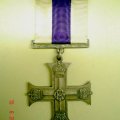
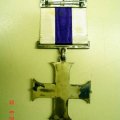 This is the front and back of his Military Cross.
This is the front and back of his Military Cross.

This is Oliver's Death Penny. It was sent to the families of those killed in action.
Recently
I was able to purchase Oliver's 1914-1918 WW1 medal (above), from E-Bay of all
places.
It was brought to my attention in a very strange and
unusual way. I was contacted by a Mr. Dave Thomson.
I have
thanked him hundreds of times and I will do it again here. Thank
you Dave for taking time to track me down.
The
following is an article taken from the Maple Leaf newspaper
courtesy of D.N.D. January 2005. Unfortunately this article is no
longer available online.
Maple Leaf, 12 January 2005, Vol. 8 No. 2, Pages 14 - 16.
"The Fourth Dimension"
By Charmion Chaplin-Thomas
January 19, 1919
In Nijni
Gora, a village upstream of Shenkursk on the Vaga River, Lieutenant
Harry H. Mead of Company A, 339th Infantry Battalion, US Army, awakes
to artillery rounds thumping in unpleasantly close to the log cabin he
shares with his platoon. The temperature is -45o F, quite normal for
sub-Arctic Russia, and the countryside lies under three feet of new
snow. The shelling develops into an intense barrage so, when dawn
finally arrives, Lt Mead takes his field glasses to the bank of the
frozen Vaga, where he can observe the plain on the other side, all the
way to the edge of the forest. At the tree-line he sees infantry wading
slowly through the fresh powder. They are the assault companies of the
Red Army, beginning the operation that will envelop Shenkursk, the
forward position of the North Russia Expeditionary Force. Realizing
that Nijni Gora is as good as lost, Lt Mead and his men slip away,
heading for Shenkursk.
Shenkursk is a charming provincial city
currently garrisoned by a multinational task force that comprises a
section of the 68th Battery, Canadian Field Artillery, a large,
well-equipped British-American hospital and a substantial White Russian
force including artillery and Cossack cavalry, as well as Company A and
Company C of the 339th Infantry Battalion. From its headquarters at
Archangel, on the coast, the NREF is strung out in defensive positions
along the railway and the Dvina and Vaga rivers. Under its British
commanding officer, Major-General Sir Edmund Ironside, its mission is
to recruit and train local men to fight the growing and increasingly
successful Red Army of the Bolshevik revolutionary government. The
Canadian contingent is the 16th Brigade, Canadian Field Artillery
(Colonel C.H.L. Sharman), a remarkably successful unit, considering the
harsh conditions, the futility of their mandate, and the soldiers’
intense desire to go home.
As the Soviet attack on Shenkursk and
its neighbouring villages develops, the platoons of Company A fall back
with their supporting Cossack cavalry toward the city, where the
garrison commander is organizing a fighting retreat to the north. In
the early hours of January 24, Lt Mead’s platoon passes through
Bolshevik lines and arrives in Spasskoe, a town perched on a bluff
above the river, where they meet Captain O.A. Mowat of the 68th
Battery, just in from Shenkursk with a sleigh-load of shells and an
18-pounder gun. At 7 a.m., a Cossack reconnaissance patrol arrives with
a report of thousands of Soviet troops moving toward Shenkursk, so Lt
Mead and Capt Mowat climb into the belfry of the village church with
their field glasses. For once, the Cossacks are not exaggerating: the
roads heading into town are full of long columns of artillery and
infantry and the plain below the bluff is swarming with Soviet soldiers.
Lt
Mead’s company commander, Capt Otto Odjard, establishes a skirmish line
on the edge of the bluff, and the Canadians dig in their 18-pounder
across the road from the church. Bellowing at the top of his lungs,
Capt. Mowat acts as forward observer, directing their fire from the
belfry. Oddly, the Soviet commander does not order an infantry assault;
either he considers it unnecessary, or perhaps his soldiers would
rather not charge the Canadians, who have a vicious reputation for
mowing down infantry with shrapnel. The Americans dig in among the
graves in the churchyard as Soviet shells strike closer and closer to
their aiming point, the church tower, until an airburst right beside
the belfry sends a hunk of shrapnel clanging off one of the bells. In
the momentary silence that follows, Capt Mowat sings out, like the
barker at a country fair, “One cigar!”, and the soldiers on the
skirmish line collapse in giggles.
A few hours later, Capt Mowat
is strolling across the road from the churchyard to the gun position
when he is cut down by a Soviet shell. The gunners pack him into a
sleigh for the four-mile trip to Shenkursk, and the American soldiers
hear his voice again: “Tell the captain I couldn’t wait.” He is dead on
arrival. Eventually Spasskoe, too, is abandoned to its fate, as is
Shenkursk in its turn.
__________________________________________________________________________
However
in reading the war diaries for this time from the Archives of Canada he
was not dead on Arrival. In the war diaries for 16th Brigade Lt. Col
C.H. Sharman wrote:
27 jan 1919 Captain Mowat is in bad shape and is
to be operated on at once. I received word from C&C that Capt Mowat
had been awarded the Military Cross for bravery at KODEMA in December
last. Also message from hospital that he was operated on but there was
little hope. I was there at once, but he was already unconscious and
died at 11pm. I pinned the ribbon of the Military Cross on him before
he died, Notified GHC and all Canadian units. Arranged for Capt. Mowat
to be buried at PIANDER, the Canadian.
On December 16 1918 it states
in the war diaries that a mobile column under command Capt Mowat 68 bty
consisting of one gun, a company of Russian Infantry, a platoon of
Americans and a troop of Cossacks returned to SHENKURSK after a fight
with the Bolshevicks 65 versts to a flank.. They were under heavy
machine gun fire here. Capt. Mowat had a peasant that knew where the
machine guns and pon-pon were located and also where the Command lived.
The 124 rounds fired at a range of 800 yards were very well invested
and direct hits all targets were obtained. This is where he
earned his Military Cross.
 Officers of the 16th Brigade, C.F.A. September 1918Oliver is sitting second from the left in the front row
Officers of the 16th Brigade, C.F.A. September 1918Oliver is sitting second from the left in the front row
A
letter written from my Grandfather Godfrey "Goog" Alden Mowat with
regards to Oliver's body being brought back to Canada. Also a reply
from Sgt. Don Seaton of the Polar Bear Expedition.
(Excerpt from ?, no date)
North Russian Campaign
May I be allowed a slight correction in reference to C. J. Jones’
letter in your January issue regarding the last Canadian casualties in
World War 1 and particularly in the North Russian campaign of 1918-19.
My brother, Captain O. A. Mowat, M. C., did not come from Moncton, as
stated by Mr. Jones, but from Campbellton, N. B. He died January
27th, 1919, south of Archangel and was buried there until June
when his Battery, the 68th, was about to return to England. His
comrades did not want to leave him there, so a coffin was made of
soldered biscuit tins and his remains were brought to England as
battery baggage. I was in Ripon with the 13thReserve Battalion
for return to Canada at that time and had an undertaker make a sealed
casket for my brother’s remains which were than forwarded to
Campbellton. A full Military funeral was held here, including a
gun carriage and firing party.
- G. A. Mowat (Major, ex-Lt. 26th Bn. C.E.F., and R.A.F., W.W. I), Campbellton N.B.
Letter from:
Dr. D. G. Seaton
104 Scarborough Road
Toronto 13
Toronto, Mar 16/68
Major G. A. Mowat
Campbellton N. B.
Dear Sir : -
I am sure I was one of the few besides yourself, who spotted the mistake in Mr. Jones’ letter.
After your brother died of wounds our Adjutant Capt. Bruce, gave me a
package of his personal papers, and possessions and told me to take
them down to British Headquarters Beregrik.(?) The parcel was
addressed to Campbellton and I handed it over to a British
Officer. I hope it reached it’s destination.
Although not a member of your brother’s battery, the 68th, I was a
sergeant with the 16thBrigade and attended your brother’s funeral at
Pianda(?). As I had a small camera, I took these pictures of his
grave, and of the burial party. You may have copies of them, but
if not I am sure they will be of special interest to you.
You may be also interested to know that Polar Bear Organization will be
holding it’s 50threunion in Detroit the end of May this year. At
our last reunion (both American and Canadian troops who served in N.B.)
held two years ago. I spoke with an American medical officer, who
was with your brother when he was wounded.
Although not
directly under Capt. Mowat’s Command, I well remember the sense of loss
throughout the whole brigade at his death, as he was held in high
esteem by both his fellow officers and men.
Personally I
am now living retired in Toronto, but memories of those long past days
and the comrades with whom I served are still as clear as ever.
Yours very tuly,
ex-Sergt. Don Seaton
News From Ollie
BACK








